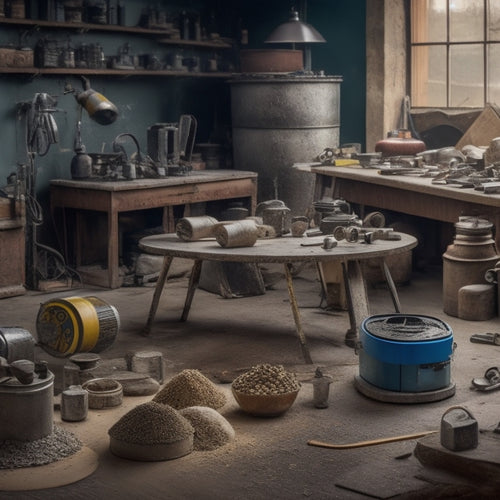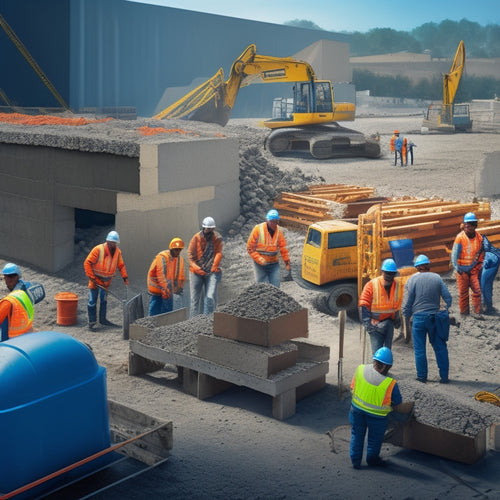
3 Best Tools for Stamped Concrete Installation Success
Share
You'll need three essential tools to guarantee a successful stamped concrete installation. First, tamping tools like tampers, jitterbugs, and darbies help compact and settle concrete, eliminate air pockets, and smooth the surface. Next, pattern mats and texture options offer a high level of detail and realism, with unique textures and durability to withstand repeated use. Finally, coloring and sealing solutions provide a vibrant palette and advanced techniques for a flawless finish. By mastering these three components, you'll set yourself up for success - and discover the nuances of each tool that can take your installation to the next level.
Key Takeaways
• A tamper is essential for compacting and settling concrete to create a solid foundation for stamped concrete installation.
• A jitterbug helps eliminate air pockets and excess water, ensuring a uniform finish and preventing defects.
• A darby is necessary for smoothing and flattening the surface, preparing it for stamping and texture application.
• Using a consistent tamping technique with an overlapping pattern helps prevent air pockets and ensures a successful installation.
• Having the right pattern mat and texture options available can greatly enhance the aesthetic appeal and realism of the final product.
Must-Have Tamping Tool Essentials
You'll need a trio of tamping tools to guarantee a successful stamped concrete installation, including a tamper, a jitterbug, and a darby, each serving a distinct purpose in the process.
The tamper is used to compact and settle the concrete, ensuring a solid foundation. The jitterbug, with its vibrating action, helps to eliminate air pockets and excess water, resulting in a more uniform finish. The darby, a long, flat tool, is used to smooth and flatten the surface, preparing it for the stamping process.
Mastering the tamping technique is essential to achieving professional-looking results.
Here are some important tips: always tamp in a consistent, overlapping pattern to avoid creating air pockets; use the tamper to compact the concrete in sections, working from the center outwards; and, when using the jitterbug, apply gentle to moderate pressure to avoid over-vibrating the concrete.
Pattern Mat and Texture Options
With a solid foundation established, it's time to select the pattern mat and texture options that will bring your stamped concrete design to life.
You'll want to choose mats that offer a high level of texture variety, guaranteeing your final product has the desired level of detail and realism. Consider mats with unique textures, such as stone or wood patterns, to add an extra layer of sophistication to your design.
When selecting a pattern mat, mat durability is also essential. Look for mats made from high-quality, heavy-duty materials that can withstand the rigors of repeated use. A durable mat will guarantee consistent, high-quality results and reduce the need for frequent replacements.
Additionally, consider the ease of use and cleaning of the mat, as well as its ability to adapt to different concrete mixes and application techniques.
Coloring and Sealing Solutions
Your stamped concrete installation requires a palette of rich, vibrant colors and a protective sealant to showcase its textured beauty and guarantee its longevity, making the right coloring and sealing solutions essential to the project's success.
With the right tools, you'll achieve a flawless finish that resists fading, cracking, and staining.
When it comes to color mixing, you need a system that allows for precise control over hue, saturation, and tone. Look for color mixing systems that offer a wide range of colors and can be easily customized to match your design vision.
For sealing, you'll want to employ advanced techniques that provide a strong, durable bond between the sealant and the concrete. This may involve using specialized equipment, such as high-pressure sprayers or roller systems, to achieve ideal coverage and adhesion.
Frequently Asked Questions
How Do I Ensure a Consistent Pattern Repeat in My Stamped Concrete Design?
When you're working on a stamped concrete design, ensuring a consistent pattern repeat is essential.
You'll want to focus on precise pattern alignment, using a leveling system or laser guide to achieve uniformity.
Additionally, consider texture variation within your pattern to create visual interest.
What Is the Ideal Temperature for Pouring Stamped Concrete?
When pouring stamped concrete, you need to take into account the ideal temperature range.
Aim for temperatures between 50°F and 80°F (10°C and 27°C) for best results.
Avoid pouring in extreme weather conditions, such as direct sunlight, high winds, or freezing temperatures.
You'll get the best results when the temperature is steady and within this range, ensuring a smooth, even finish and a strong, durable concrete slab.
Can I Use a Power Trowel to Finish Stamped Concrete?
As you're pouring stamped concrete at the ideal temperature, you're probably wondering if a power trowel is the right tool to finish the job.
Coincidentally, a power trowel is an excellent choice, offering benefits like increased efficiency and uniformity.
When using a power trowel, you'll achieve precise finishing techniques, such as removing excess concrete and achieving a smooth, even surface.
With the right technique, you'll reveal the full potential of your stamped concrete design.
How Long Should I Wait Before Sealing My Stamped Concrete?
You're enthusiastic to seal your stamped concrete, but don't rush it!
You should wait until the concrete has fully cured, which typically takes 28 days. Any sooner, and you risk trapping moisture beneath the sealant, leading to delamination or discoloration.
Once cured, choose the right sealing techniques for your project, considering factors like traffic, climate, and desired finish.
Is It Possible to Stamp Concrete Over Existing Concrete Surfaces?
'Alas, ye olde concrete surfaces, canst thou be reborn? Yes, it's possible to stamp concrete over existing surfaces, but thou must prepare thy ground wisely.
Existing surface preparation is key. Verify the surface is clean, dry, and free of cracks. Then, apply a bonding agent to create a strong bond between old and new concrete.
With proper prep, thou shalt release the stamped concrete benefits of durability, low maintenance, and aesthetic appeal, fit for a king (or queen)!'
Conclusion
With these three top-tier tools in your arsenal, you'll be well-equipped to tackle even the most complex stamped concrete installations.
Masterful manipulation of must-have tamping tools, pattern mat and texture options, and coloring and sealing solutions will morph mediocre makeovers into majestic masterpieces.
By marrying meticulous planning with these mighty machinery, you'll confidently craft coveted concrete creations that captivate and inspire.
Related Posts
-

What Tools to Rent for a Concrete Home Reno
When tackling a concrete home renovation, you'll need to rent a variety of specialized tools to get the job done. For...
-

Top DIY Concrete Grinding and Polishing Tools
When selecting DIY concrete grinding and polishing tools, you'll want to take into account a range of factors to guar...
-

7 Best Tools for Concrete Block Construction
You'll need a solid foundation, precise cutting, and seamless finishing to guarantee your concrete block construction...


